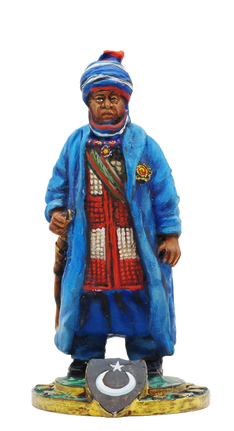
Muhammadu Attahiru II
Sultan of Sokoto
Muhammadu Attahiru II was the thirteenth Sultan of the Sokoto Caliphate from 1903 to 1915. Attahiru II was the great grandson of Usman dan Fodio, the founder of the Sokoto Caliphate and son of Ali Babba bin Bello, the fourth Sultan. Upon the death of the eleventh sultan Abderrahman dan Abi Bakar in 1902, Attahiru II was the primary challenger to the candidacy of Muhammadu Attahiru I, with the later being selected as the Sultan. After losing this selection to Attahiru I, it is claimed that Attahiru II became largely uninterested in the affairs of the Caliphate. In 1903, British forces conquered Sokoto leading Attahiru I to flee from the city with many supporters. British Commander Frederick Lugard appointed Muhammadu Attahiru II the new Sultan of Sokoto on March 21, 1903. However, at the same time Lugard stripped much of the political power of the office of Sultan. Attahiru's reign consisted of balancing his need to both serve the people he ruled and satisfy the British colonial authorities. In 1906, a Mahdist rebellion broke out outside the city of Sokoto in the village of Satiru. Elements of the Royal West African Frontier Force were dispatched to suppress the rebellion; upon hearing news of what had transpired, Attahiru dispatched a mixed force of 300 Sokoto cavalry and infantry led by Mallam Isa to join them. The combined force

successfully suppressed the rebellion, which marked the last instance of armed resistance to British rule in the region.

The military of the Sokoto Caliphate, which was commanded by the Sarkin Yaki (war commander) the title still held by the descendants of Ali Jedo, at the time of the jihad was organized into a standing army and a cavalry. The standing army was composed of Hausa and Fulani warriors who were trained in warfare and were responsible for the Caliphate's defense and the expansion of its territories. The cavalry was an essential part of the military, as horses were the primary mode of transportation during this period. During the expansion, the Caliphate's military utilized a strategy of establishing emirates in conquered territories. These emirates were governed by emirs, who were either appointed by the Sultan or were local rulers who had submitted to the Caliphate's authority. This strategy helped in maintaining control over the vast territories of the Caliphate. The Sokoto Caliphate relied heavily on the use of cavalry in its military campaigns. The Fulani horsemen, renowned for their equestrian skills, formed the core of the Caliphate's cavalry. They were instrumental in the rapid expansion of the Caliphate's territories. Parfait-Louis Monteil, the french explorer who visited the caliphate in 1890, claimed that he witnessed Sultan Umaru bin Ali raise "an army of forty thousand men,
half of whom were cavalry, to lay siege to Argungu." Additionally, the Caliphate's military strategy involved a system of alliances with local rulers. In some cases, these rulers were allowed to maintain their positions under the condition that they pledged allegiance to the Caliphate and adopted Islam. This strategy helped to solidify the Caliphate's control over conquered territories. The military expansion of the Sokoto Caliphate had significant social, political, and economic impacts. It led to the spread of Islam and the Fulani language and culture in the region. The Caliphate's rule also resulted in changes in local governance systems and the economy, with the introduction of new administrative structures and trade networks.

The sultan of Sokoto is the leader of the Sokoto Caliphate, a Sunni Muslim community in West Africa. The position may also be referred to as the 'Sokoto Caliph' or the "Commander of the Faithful" (Amir-ul-Momineen in Arabic or Lamido Julbe in Fulani). The sultan of Sokoto is the leader of the Qadiriyya Sufi order, historically the most important Muslim position in Nigeria and senior to the Emir of Kano, the leader of the Tijaniyya Sufi order. The post has become increasingly ceremonial since British rule defeated the caliphate and replaced it with the Sokoto Sultanate Council in 1903, but the sultan – considered a spiritual leader in the Muslim community in Nigeria – can still carry much weight with Fulani and Hausa people from northern Nigeria. Usman dan Fodio, the founder of the dynasty of Sokoto State and of the Fulani Empire (consisting of the Fulbe Jihad states of which Sokoto was suzerain), never used the high style of Sultan but was simply titled Amir al-Mu´minin . The first to assume the title of Sultan was Fodio's son Muhammed Bello, who ruled from 1817 to 1837. Since the creation of the title, there have been nineteen Sultans of Sokoto, all men from the Torodbe scholar caste who are descended from Usman dan Fodio. Siddiq Abubakar III was the longest serving Sultan,
holding the position for 50 years from 1938 to 1988. The shortest reign was that of Muhammadu Attahiru I, who held the position for five months in 1902–03. The 17th sultan, Ibrahim Dasuki, was forcefully deposed in 1996 by the Sani Abacha military government of Nigeria. Prior to the beginning of the Fulani Jihad of 1804, the ethnic category Fulani was not important for the Torodbe and their literature reveals the ambivalence they had defining Torodbe-Fulani relationships. They adopted the language of the Fulani and much ethos while maintaining a separate, non-ethnic identity. The Torodbe clan at first recruited members from all levels of Sudani society, particularly the poorer people.
Awards: Collar, sash and star of the Order of Osmanieh (Osmaniye Nisanı).






